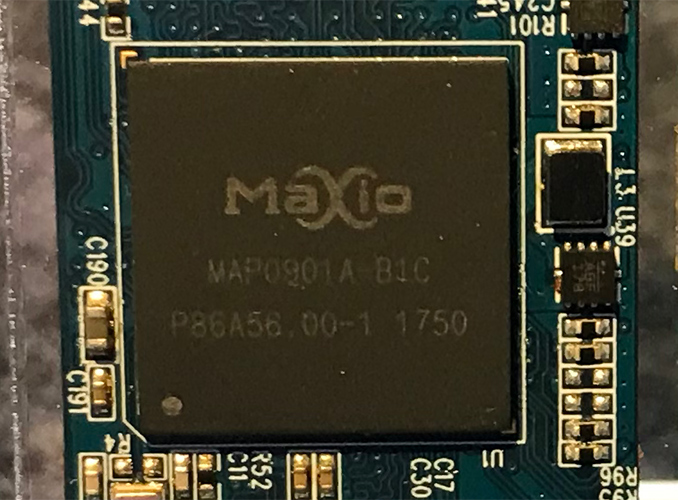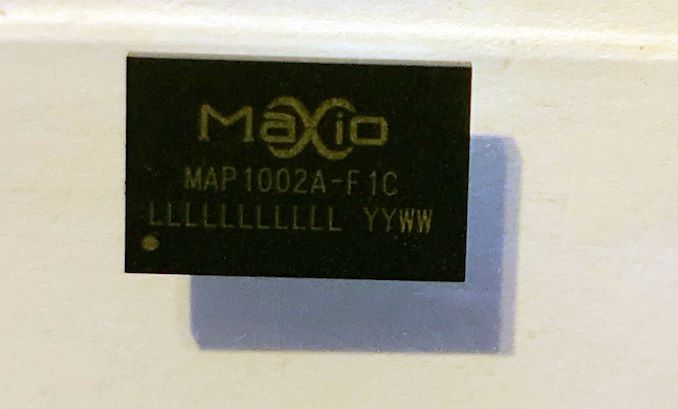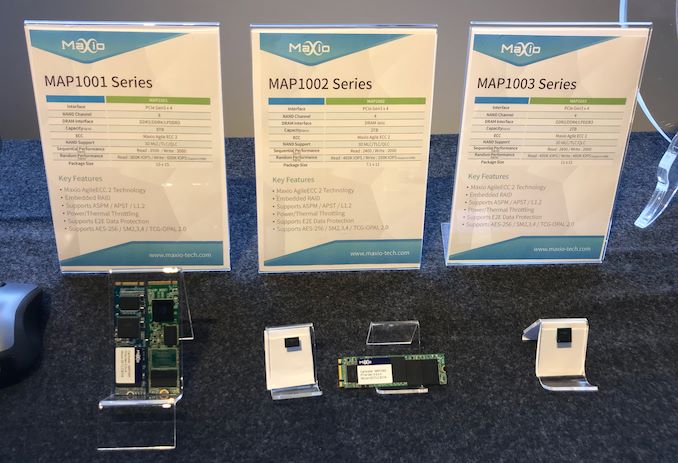Maxio Technology: New Line of Cheaper NVMe SSD Controllers
by Anton Shilov on June 7, 2019 2:00 PM EST- Posted in
- SSDs
- Storage
- Trade Shows
- Maxiotek
- Maxio Technology
- Computex 2019

Known primarily for controllers designed for inexpensive SATA SSDs, Maxio Technology is now expanding into the space of higher-performance drives featuring a PCIe interface. At Computex, the company demonstrated its MAP1000 lineup of PCIe SSD controllers aimed at cheaper (as well as higher-end) solutions.
Maxio’s family of PCIe SSD controllers includes three chips: the MAP1001 with 8 NAND channels for advanced drives, the MAP1003 with 4 NAND channels for mainstream SSDs, and the MAP1002 with 4 NAND channels for the cheapest DRAM-less solutions. As far as compatibility is concerned, the Maxio MAP1000-series controllers can work with various types of 3D MLC/3D TLC/3D QLC memory from different manufacturers and feature a PCIe 3.0 x4 interface.
When it comes to performance, Maxio says that drives powered by the MAP1001 will offer up to 3.5 GB/s sequential read speed, up to 3 GB/s sequential write speed, up to 800K read IOPS, and up to 600K read IOPS when used with 3D NAND ICs featuring a 800 MT/s interface. SSDs based on other controllers will be tangibly slower (at up to 2.4 GB/s sequential read speed), but will still outpace SATA drives by a very considerable margin.
| Maxio Technology's MAP1000-Series PCIe SSD Controllers | |||
| Model | MAP1001 | MAP1003 | MAP1002 |
| Number of NAND Channels | 8 x 4 CE | 4 x 4 CE | |
| NAND Interface | Toggle 2/3, ONFI 3/4, 800 MT/s, VCCQ 1.8V/1.2V | ||
| DRAM Interface | DDR3, DDR4, LPDDR3 | - | |
| NAND Flash | 3D MLC/3D TLC/3D QLC Micron, Intel, Toshiba, Western Digital, SK Hynix, YMTC, UNIC, Samsung |
||
| Interface | PCIe 3.0 x4, NVMe 1.x | ||
| Sequential Read | 3500 MB/s | 2400 MB/s | |
| Sequential Write | 3000 MB/s | 2000 MB/s | |
| Random Read IOPS | 800K IOPS | 400K IOPS | 400K IOPS |
| Random Write IOPS | 600K IOPS | 400K IOPS | 350K IOPS |
| Maximum Capacity | 8 TB | 2 TB | 2 TB |
| ECC | Maxio Agile ECC 2 (LDPC) | ||
| Pseudo-SLC Caching | Supported | ||
| E2E Data Protection | Yes | ||
| Encryption | AES-256, TCG-OPAL 2.0, SHA256, SM2, SM3, SM4 | ||
| Power Management | ASPM, APST, L1.2 | ||
| Power, Thermal Throttling | Yes | ||
| Embedded RAID | Yes | ||
| TBW | 15 x 15 mm | 11 x 11 mm | 7.1 x 11 mm |
| Process Technology | 28 nm | ||
On the feature side of things, the controllers feature Maxio’s AgileECC 2 technology (think 2nd generation implementation of its LDPC-based technology); embedded RAID capabilities; end-to-end data protection; AES-256, TCG-OPAL 2.0, and China-specific SM2, SM3, and SM4 encoding; advanced power management, and so on. All the controllers are made using a 28 nm process technology, so the chips are not too expensive to manufacture (just look at their dimensions).
Maxio’s customers will test the company’s MAP1001 and MAP1002 controllers in the third quarter and at least some of them will be able to roll out commercial drives on their base sometimes late this year or early in 2020.
| Want to keep up to date with all of our Computex 2019 Coverage? | ||||||
 Laptops |
 Hardware |
 Chips |
||||
| Follow AnandTech's breaking news here! | ||||||
















7 Comments
View All Comments
MajesticTrout - Friday, June 7, 2019 - link
That drive with the blue pcb is labeled as PCIe 3.0 x4, but isn't it keyed for x2?Death666Angel - Saturday, June 8, 2019 - link
B+M doesn't have a distinction between x2 and x4. M only would be x4 and B only would be x2 (as well as A and E).erinadreno - Saturday, June 8, 2019 - link
Since there's a B key, it means that ssd can only run at x2. B+M is only for installing it in a M key socket. If a key indicates narrower bandwidth is present, the wider one doesn't matter.MrCommunistGen - Friday, June 7, 2019 - link
I think it is interesting that each of the models has a separate package size (table on-site says "TBW" but the attached pics say "Package Size"). I'd have expected using the same die/controller and just disabling/fusing off unneeded features for product segmentation to avoid having to pay tape out and manufacturing on 3 different chips.Regardless -- based on the heritage of the Maxio IP (JMicron), they're going to have to demonstrate that they can deliver their stated performance without major tradeoffs or issues - even if they're just looking to fill the value segment.
zepi - Saturday, June 8, 2019 - link
Cheapest model doesn’t require pins for external DDR and only the best model has all nand-channels + DDR interface.I suppose that for laptop and tablet customers who might integrate this to motherboards, every square-mm is worth something.
Maybe smaller packaging even saves them a penny on each chip.
Death666Angel - Saturday, June 8, 2019 - link
They really should start integrating some sort of SSD into modern laptop motherboards.Otherwise, I don't get the appeal of these low end controllers, at least for the end user. SSD pricing still seems to be 99% NAND, so at the capacities I look at (500GB to 2TB), the cheapest SSDs are the ones from known brands with good to great controllers. The NVME x2 SSDs or cheap JMicron SSDs with 4 channels are often not cheap enough to justify the performance and unknown reliability drawbacks. And the normal controller SSDs are on sale so often that it really doesn't make sense to buy an SSD with this kind of controller yourself. Now for OEM use, I guess the story might be different. And we're at a point where I expect any SSD to perform significantly better in most circumstances and not worse in any than a traditional HDD, regardless of vendor.
damianrobertjones - Wednesday, June 12, 2019 - link
Lower, mid, high end tiers. The segregated lines that enable a company to charge x, y, as well as Z. have a range pf products that sell well, release a 'supposedly' cheaper part and then increase the price of the latest and greatest which doesn't offer much above the last higher end part.Business. Ripping us off all day long.